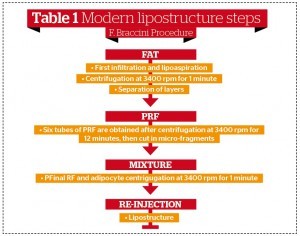Method
Between May 2005 and June 2012, the effect of PRF was studied in 232 patients (modified Coleman method). The patients ranged from 39 to 72 years of age, the average of which was 59 years. Lipostructure was carried out in an isolated way in 79 patients, and combined with a cervicofacial lift and/or blepharoplasty in 153 patients. No patient had to undergo a second lipostructure.
For an isolated lipostructure, the intervention is carried out under neuroanalgesia in ambulatory surgery. Surgical procedures are performed under general anaesthesia.
Fat harvest
Lipostructures are generally carried out according to the protocols described by Dr Coleman3–6, but with refinements in this case. Fat tissue is extracted from the inner side of the knees and supplemented with a paraumbilical extraction if necessary. The extraction is done using a specific aspiration nozzle with a diameter of 3 mm and 15 cm length, with foam ends and openings at both sides. A 10 ml syringe is screwed onto the nozzle. The vacuum in the syringe is created manually and gradually to avoid a build-up of pressure on the adipocytes. There are multiple tubes leading out to limit trauma and bleeding. On average, 60 cc of fat is extracted, which varies from patient-to-patient and depends on the indication and quantity needed for re-injection.
The purification process then follows by means of centrifugation of the extracted tissue. The 10 ml syringes are sealed using stoppers and placed in the centrifugal machine. Centrifugation (shorter) is carried out for only 1 minute at a speed of 3400 rpm. After centrifugation, the contents of the syringe are divided into three layers. The upper oily sample of adipocytes consists of triglycerides from the damaged adipocytes and has the lowest density. This part, usually eliminated, is kept to humidify the membranes with PRF. The bottom sample primarily contains the blood debris, which ceases when the syringe is withdrawn. The middle sample contains the adipocytes to be grafted. On average, the graft makes up 6cc of the syringe.

Figure 2 HIV-positive patient, aged 38 years, (A) before bilateral lipostructure with platelet-rich fibrin, (B) immediately postoperative, and (C) 6 months postoperatively
Obtaining the PRF
To produce the PRF, 40–60 ml of blood is taken in four to six tubes, without anticoagulant (Becton Dickinson Vacutainer 10 ml). These are immediately centrifuged for 10 minutes at 3400 rpm according to the protocol described by Choukroun et al18–21.The activation of coagulation and centrifugal forces create three layers in the tube: a red blood corpuscle base at the bottom, a plasmatic acellular at the surface, and a clot of fibrin PRF charged in platelets in the middle. Clots of PRF are collected using forceps. These are separated from the red blood corpuscle base and are placed into a cup. The fibrin PRF clot is cut into 1–2 mm fragments, which are mixed with the oil sample produced by fat centrifugation. This mixture is put into a 1 ml syringe and placed using a nozzle (in line with Dr Coleman’s method of tunnelisation) on the principal sites to be grafted before the installation of purified fat.
PRF is produced using a centrifuge, such as the PC-02 (Process, Nice, France). The result is a fibrin clot rich in platelets. This is cut into small pieces before use (Figure 3).Once cut out and mixed, each clot represents a volume of injection of approximately 1 cc; half made up of fibrin PRF matrix, and the remainder in a liquid state (plasmatic serum and a purified sample of adipocytes).
On average, four to six clots of PRF are sufficient to treat a complete face: six clots for complete lipostructure and four clots for lipostructure with cervicofacial lift. The deposit of PRF before the injection of the fat grafts is used for preparation and activation at the site for graft implantation.
Mixture
The author performs a last centrifugation with fat and pieces of PRF for a further minute at 3400 rpm.




